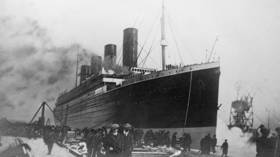First 3D scans of Titanic shipwreck published

The first full-sized 3D reconstruction of the doomed ocean liner Titanic has revealed new details about the world’s most infamous shipwreck, some 111 years after it sank in the Atlantic while making its maiden voyage to New York. The tragedy resulted in the deaths of more than 1,500 passengers and continues to resonate to this day.
The series of high-resolution images released online were made using deep-sea mapping technology that combined more than 700,000 scans of the Titanic shipwreck to form a never-seen-before view of the mangled vessel, which permanently rests 3,800m (12,500ft) on the ocean floor around 370 miles (594 kilometers) off the coast of Newfoundland, Canada.
“It allows you to see the wreckage as you can never see it from a submersible,” Titanic expert Parks Stephenson told the BBC on Wednesday. “You can see the wreck in its entirety, you can see it in context and perspective.”
Stephenson added that despite Titanic being the most famous shipwreck in history, innumerable questions remain following its sinking after striking an iceberg in 1912 – such as the impact point of the iceberg, or the exact nature in which the ship struck the ocean floor.
The project was undertaken in 2022 by deep-sea mapping company Magellan Ltd in conjunction with Atlantic Productions, who are making a documentary film on the subject. So precise was the imaging that unopened bottles of champagne were observed around the wreckage, as well as a serial number on one of the propellers.
The mapping required the participation of a team of experts who piloted remote-controlled submersibles to observe every angle of the Titanic, spending more than 200 hours in total taking close to three-quarters of a million scans.
“The challenge is that you have to map every square centimeter – even uninteresting parts, like on the debris field you have to map mud, but you need this to fill in between all these interesting objects,” said Gerhard Seiffert of Magellan Ltd to the BBC.
With experts predicting that the Titanic will eventually rust away into nothingness by around 2050, Parks Stephenson says that it is crucially important to document every element of the Titanic while it remains possible, which he says is “the last surviving eyewitness to the disaster.”
And, for the time being at least, Stephenson says that “she has stories to tell.”












